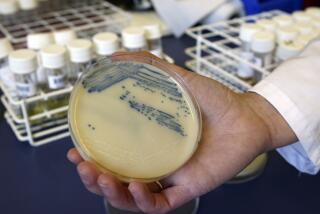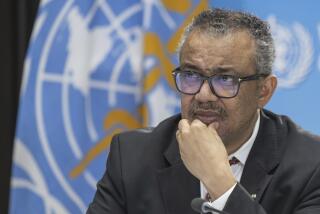TB infection rate may be on ‘threshold of decline’
- Share via
For the first time in modern history, the rate of infections in the global tuberculosis epidemic has leveled off and may be on the “threshold of decline,” the World Health Organization announced today.
The percentage of the world’s population struck by TB peaked in 2004 and then held steady or even declined in 2005, according to the report, but the actual number of new cases increased to 8.8 million because of the growing world population.
Dr. Mario Raviglione, director of the WHO’s Stop TB Department, said the figures represented the “first time ever” that TB rates had declined.
“Incidence has peaked around the world,” he said. “This is fruition of all our efforts.”
The announcement marks a milestone in the fight against TB, which the WHO declared a global health emergency in 1993 because of skyrocketing infections.
Since then, the number of deaths has declined from more than 3 million to 1.6 million in 2005, the report said.
The epidemic is centered primarily in Asia and sub-Saharan Africa, which accounted for 7.4 million new cases in 2005, or 84% of the total.
“Nearly 60% of TB cases worldwide are detected, and out of those, the vast majority are cured,” United Nations Secretary-General Ban Ki-moon said in a statement. “Over the past decade, 26 million patients have been placed on effective TB treatment.”
Dr. Lee Reichman, executive director of the Global Tuberculosis Institute at the University of Medicine and Dentistry of New Jersey, cautioned that TB remained a wily opponent.
One of the major concerns is the emergence of “basically untreatable” TB -- strains of the disease known as multi-drug resistant and extensively drug resistant TB.
Experts fear that either or both of those strains could gain a stronger foothold in the population, reversing the successes in treatment. The emergence of the strains has raised alarms even in countries with well-developed public health programs that have largely controlled the disease.
Treatment of drug-resistant TB strains costs nearly twice as much as treating conventional TB and takes much longer.
“With TB, we have learned through painful lessons that you should never declare victory prematurely,” said Dr. Kenneth Castro, director of the Centers for Disease Control and Prevention’s Division of Tuberculosis Elimination. “The moment you relent, TB has an incredible ability to come back with a vengeance.”
He said that in the U.S., tuberculosis seemed to be firmly under control in the mid-1980s, but that the rate started sharply climbing again when chest clinics were closed and TB funds were diverted to other diseases.
The CDC is expected to announce today that the number of tuberculosis cases in the United States reached a record low in 2006, after 14 consecutive years of decline. In its last report, the CDC reported 14,085 new cases in the U.S. in 2005.
The California Department of Health Services is to also announce a record low number of cases in the state, which contributes the most cases to the national total. More than 75% of California’s cases occurred among foreign-born individuals.
Tuberculosis, once called “consumption” because of the way people wasted away, is one of the oldest known diseases. It is an often-lethal infection of the lungs characterized by fever, weight loss, night sweats and coughing up blood.
Saturday, World Tuberculosis Day, marks the 125th anniversary of German bacteriologist Robert Koch’s discovery of Mycobacterium tuberculosis, the microorganism that causes TB.
The bacterium spreads in microscopic droplets released when an infected person coughs, sneezes, laughs or speaks, and infection occurs primarily through prolonged close contact. Once a person is infected, the bacterium can lie dormant for days to years.
Unlike most common bacterial infections, tuberculosis is difficult to cure. Treatment of an active infection usually entails taking four antibiotics for two months, then two antibiotics for four more months. In the past, patients often stopped taking their drugs after a few weeks, leading to a recurrence of the disease.
Incomplete treatment is the primary source of drug-resistant TB.
The WHO report noted that the incidence in 2005 of these hard-to-cure strains was not as high as was expected. But it attributed that apparent good news to poor detection of the strains in developing countries.
One of the major reasons for the improvement in cure rates reported by the WHO is the implementation of a technique called directly observed therapy, in which health workers watch patients swallow each dose of the drugs.
Nearly 90% of the world’s population now lives in areas where public health services have implemented directly observed therapy programs, the report said.
Africa and Eastern Europe were the last regions to stabilize their TB infection rates. Rates have been declining in the rest of the world for several years.
The WHO’s Raviglione attributed some of the gains in tuberculosis control to a slowing of the HIV epidemic in Africa. TB preys on AIDS patients, whose immune systems are compromised, killing 195,000 AIDS patients worldwide in 2005.
“The African HIV epidemic has slowed down, and perhaps has peaked in 2005,” he said.
Castro, of the CDC, also cited an increase in political will to fight the disease: commitments made in countries such as China and Russia to make tuberculosis control a priority.
Funding increases have also helped the detection and treatment of TB. Since 2002, total funding has nearly doubled to about $2 billion this year. That figure reflects not only increased funding from donor nations, but also substantial increases in domestic funding in China, the Russian Federation and South Africa.
“This shows that spending more money on these issues actually works,” said Jon Liden, a spokesman for the Geneva-based Global Fund to Fight AIDS, Tuberculosis and Malaria.
Current funding levels are not high enough, however, the report said. An additional $1.1 billion would be required in 2007 to meet the requirements set by the Global Plan to Stop TB, established last year.
At least $56 billion would be necessary to carry out the plan’s 10-year program, but current funding commitments indicate a gap of at least $31 billion.
*
jia-rui.chong@latimes.com






